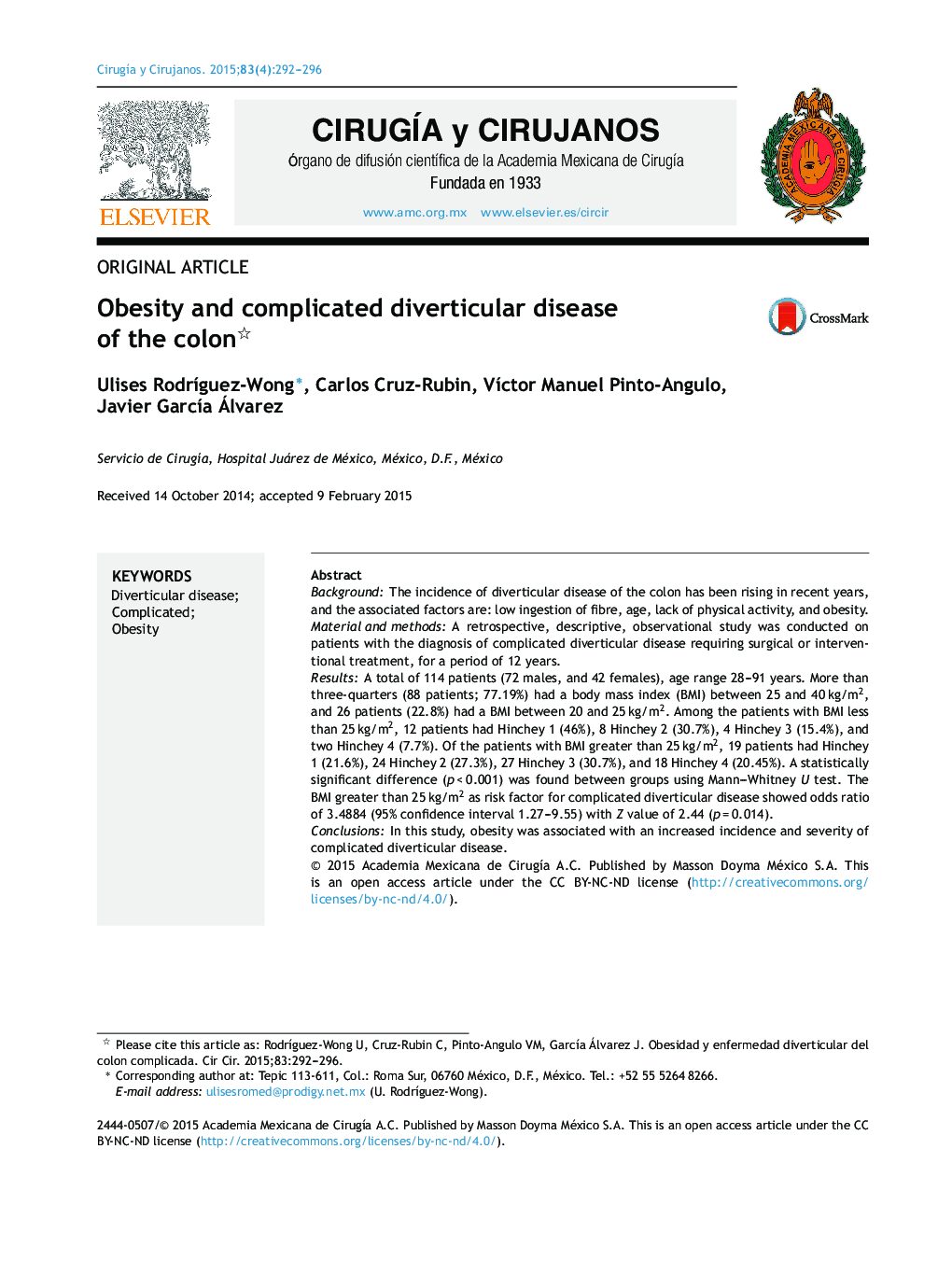| کد مقاله | کد نشریه | سال انتشار | مقاله انگلیسی | نسخه تمام متن |
|---|---|---|---|---|
| 4283441 | 1286887 | 2015 | 5 صفحه PDF | دانلود رایگان |
BackgroundThe incidence of diverticular disease of the colon has been rising in recent years, and the associated factors are: low ingestion of fibre, age, lack of physical activity, and obesity.Material and methodsA retrospective, descriptive, observational study was conducted on patients with the diagnosis of complicated diverticular disease requiring surgical or interventional treatment, for a period of 12 years.ResultsA total of 114 patients (72 males, and 42 females), age range 28–91 years. More than three-quarters (88 patients; 77.19%) had a body mass index (BMI) between 25 and 40 kg/m2, and 26 patients (22.8%) had a BMI between 20 and 25 kg/m2. Among the patients with BMI less than 25 kg/m2, 12 patients had Hinchey 1 (46%), 8 Hinchey 2 (30.7%), 4 Hinchey 3 (15.4%), and two Hinchey 4 (7.7%). Of the patients with BMI greater than 25 kg/m2, 19 patients had Hinchey 1 (21.6%), 24 Hinchey 2 (27.3%), 27 Hinchey 3 (30.7%), and 18 Hinchey 4 (20.45%). A statistically significant difference (p < 0.001) was found between groups using Mann–Whitney U test. The BMI greater than 25 kg/m2 as risk factor for complicated diverticular disease showed odds ratio of 3.4884 (95% confidence interval 1.27–9.55) with Z value of 2.44 (p = 0.014).ConclusionsIn this study, obesity was associated with an increased incidence and severity of complicated diverticular disease.
ResumenAntecedentesLa incidencia de la enfermedad diverticular del colon ha aumentado en los últimos años, los factores de riesgo identificados son: baja ingestión de fibra, edad, ausencia de actividad física y obesidad.Material y métodosEstudio retrospectivo, observacional y descriptivo en pacientes con diagnóstico de enfermedad diverticular complicada, que requirieron de tratamiento quirúrgico o intervencionista, durante un periodo de 12 años.ResultadosSe incluyeron 114 pacientes (72 hombres y 42 mujeres), el rango de edad fue de 28 a 91 años. 88 pacientes (77.19%) tuvieron un índice de masa corporal (IMC) entre 25 y 40 kg/m2 y 26 pacientes (22.8%) tuvieron un IMC entre 20 y 25 kg/m2. Dentro de los pacientes con IMC menor a 25 kg/m2, 12 tuvieron una clasificación de Hinchey 1 (46%), 8 Hinchey 2 (30.7%), 4 Hinchey 3 (15.4%), y 2 Hinchey 4 (7.7%). De los pacientes con IMC mayor a 25 kg/m2, 19 presentaron Hinchey 1 (21.6%), 24 Hinchey 2 (27.3%), 27 Hinchey 3 (30.7%) y 18 Hinchey 4 (20.45%). Mediante prueba de U de Mann-Withney se identificó una diferencia estadísticamente significativa (p < 0.001) entre ambos grupos. El IMC mayor a 25 kg/m2 como factor de riesgo de enfermedad diverticular complicada mostró una razón de momios de 3.4884 (intervalo de confianza 95%, 1.27–9.55) con valour de Z de 2.44 (p = 0.014).ConclusionesEn este estudio, la obesidad se relacionó con una mayor incidencia y gravedad de enfermedad diverticular complicada.
Journal: Cirugía y Cirujanos (English Edition) - Volume 83, Issue 4, July–August 2015, Pages 292–296
